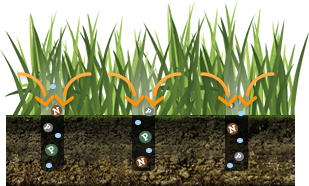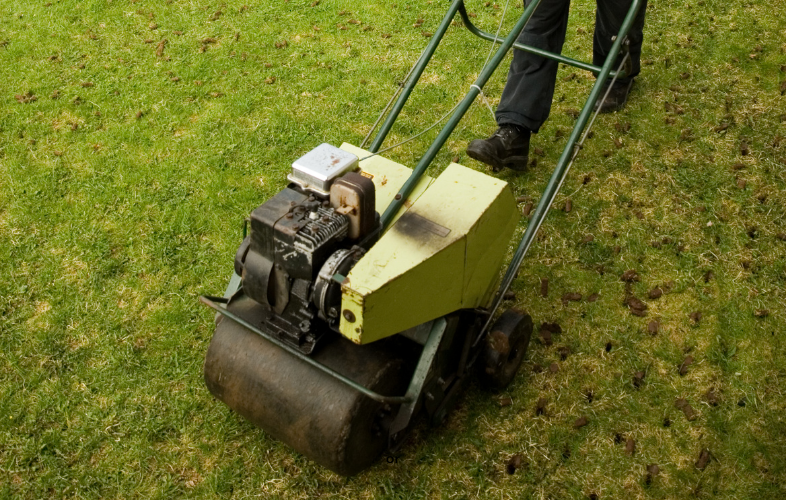Why Aeration is Essential to Long-Term Lawn Health
Reading time: 2 minutes
Getting a healthy lawn requires dedication to regular services. These annual services, like aeration, can dramatically improve the health of your soil and lawn. Specifically, you use aeration to avoid soil compaction and optimize growth.
Understanding this all-important service is just the first step. If you’ve never considered aeration as an option for your annual lawn care, it’s time to consider professional services for your lawn. Aerating your yard with the help of a professional breaks up tough soil and encourages the development of a thriving, lush lawn.
What Is Aeration?
The aerating process uses equipment to remove large plugs of soil from the lawn. By pulling out these plugs, compacted soil has more space to spread out and loosen. Looser soil has more air incorporated into it for a lighter texture that encourages healthier plant growth.
Depending on the specific tools, the equipment extracts cores up to ¾ inches wide by up to 4 inches long. The core aerator removes these plugs every 2 to 6 inches. Once finished, the aerator will leave the plugs on your lawn.
After the lawn care experts finish aerating your soil, you may want to remove the cores left on the lawn, but these plugs have a purpose. They carry essential nutrients from deep in your soil and release them to the grass on the surface.
Leave the cores in place to dry and mow over them the next time you cut the grass. While the plugs sit on top of your grass, they'll return their nutrients into your lawn to improve the grass's health. After mowing once or twice, you should no longer see the plugs, and your grass should also begin to appear healthier and fuller.
Your lawn may look messy for a short time, but aerating will give you a healthier lawn with better grass growth and fewer weeds.
How Aeration Helps Your Lawn
Even if you start with good, well-aerated soil in your lawn, most soils will settle and become more dense over time. Frequent walking over the soil and its composition also affect how quickly compaction occurs.
Aeration restores the naturally open texture of your soil by removing cores and depositing them on top of the grass. The remaining soil under the grass will loosen as it fills the spaces. Grass seeds and roots will also grow in these spaces to fill out bare spots if you overseed after aerating your lawn.
Grassroots rely on the soil for air, nutrients, and water. Loose, well-aerated soil allows air to permeate into the ground near the grassroots, where a proper exchange of gases can occur. Also, roots grow easier through loose dirt and can more readily absorb nutrients and moisture.
Aeration also helps with breaking up and preventing thatch in your lawn. Removing cores from the soil will cut through thin layers of thatch. Additionally, the extra airflow to the ground and healthier grass protect your lawn from thatch formation in the future.
If you combine aeration with overseeding, your lawn can grow even healthier. Overseeding adds extra grass seed to encourage thick, lush growth, which chokes out weeds before they can proliferate in your yard. Aerating and overseeding create a powerful combination for improving the appearance and health of your lawn.

Signs You Should Aerate
Most homeowners will see benefits in their yard's growth from aerating it. Loosening compacted soil and increasing grassroots access to oxygen, nutrients, and moisture helps all yards. In some cases, your yard will desperately need aeration. If it does, you'll notice some of the following signs:
- You cannot push a screwdriver into moist soil.
- Your lawn has puddles after rain, indicating poor water drainage into the soil.
- You have areas of heavy foot traffic.
- Your property has heavy thatch.
- You have heavy soil.
Aerating annually makes it easier to prevent lawn and soil compaction issues.
Benefits of Lawn Aeration
You don’t need to do aeration more than once a year. But when you add this service to your annual lawn care, you can reap the long-term benefits – whether you need help with soil compaction and moisture, ensuring proper nutrient absorption, or getting a fuller-looking lawn.
Improves Moisture Use by Lawns
If your lawn has puddles due to poor water absorption after rains, aeration can help control the problem. When soil becomes compacted, it does not allow water to flow through it as easily.
The grassroots will also find it more challenging to take in water. Aerating your lawn eliminates puddles caused by poor soil drainage and will help your grass use available water.
Enhances Nutrient Uptake by Grass
For healthy grass, the roots need to "breathe" and absorb nutrients in the soil. Tightly compacted soil prevents both.
Following aeration, the soil loosens. Air from the atmosphere and minerals from the ground can reach the grassroots more easily. With better air exchange and mineral availability, your grass is on its way to vibrancy.
Thickens Grass and Prevents Weeds
Aerating your lawn will help you have fuller grass growth throughout your yard. The core plugs removed from your property become ideal spots for new growth. After aeration, your lawn will become more lush as new grass emerges.
This is where overseeding comes in. You’re able to add more variety to your grass and ensure more growth. Thus promoting a thicker, healthier lawn. The Green Drop team usually does these services together because of these bonus benefits.
Plus, when you aerate your lawn in the fall, the grass will be in an active growing phase, while many weeds are not. Therefore, you'll encourage grass growth, which will block out the emergence of weeds, giving you a uniform lawn.
Breaks Up Thatch and Prevents Future Problems
Aeration can address and prevent thatch in your lawn. This layer of turf and decaying plant matter can prevent moisture from penetrating the soil. It also can harbour pests that can damage your lawn or cause physical or microbial damage.
While some thatch can be good, you want to prevent it from taking hold in your lawn because its building rate outpaces its decaying speed. The leading cause behind this rapid development of thatch is lignin, which makes up a quarter of thatch's composition. Microbes have more difficulty breaking down lignin than the remaining three-fourths of the thatch's organic matter. This problem can worsen if your soil is compacted because the microbes needed for decay are lower.
Removing plugs from your soil breaks up minor cases of thatch. The air, now reaching the soil, encourages the growth of beneficial microbes. These microbes break down organic material and prevent thatch from developing later.
Helps the Overseeding Process Succeed
If you want to overseed to improve your lawn or grow a new type of grass, it’s important to aerate it first for best results. Aerating will give the new seeds room to take root and have the nutrients, air, and moisture available to grow well. Your lawn can then grow thicker because the holes in the soil allow for better germination and less waste of seeds.
Why You Should Aerate Using Professional Services
To get the most benefits from aeration, working with experts in lawn care and aeration is essential. Because they understand best practices, use specialized tools, and can combine multiple services more easily, you’ll have less to worry about and more time to enjoy a healthy, vibrant lawn.
Improved Methods
If you try to aerate your lawn yourself, you may cause more harm than good. Some common mistakes people make include aerating a lawn that is too wet or dry or doing it at an inopportune time of the year.
Lawn care professionals have finely tuned their aeration methods to combat compaction efficiently. An expert will also have undergone training and understand best practices to use scientific applications, meaning quicker service calls.
High-Quality Equipment
Homeowners typically have limited access to core aerators due to their high cost. Since many homeowners lack industry knowledge, using the wrong equipment is even more likely.
For example, you may think that you should use a spike aerator. Unlike core aerators that remove soil to improve airflow and loosen compacted dirt, spike aerators press down the lawn even more and cause more compaction.
For those who do want to get a core aerator, renting the equipment, transporting it to the yard, taking it back to the rental site, and taking the time to do the job could cost even more than having a professional lawn care provider do the work instead.
When you choose a professional service, you can eliminate wasted time, money, and effort. Instead, you get a beautiful lawn without potentially using the incorrect equipment or worrying about renting and returning equipment on your own.
Bundle Services to Save Time
When you work with a professional lawn care provider, you can bundle several services to save on the overall cost and time required. For example, if you want to aerate your lawn and then overseed it, you can schedule a professional to do both simultaneously.
Professional lawn services ensure a healthy lawn without requiring you to spend all your free time maintaining it.
What Time of Year Is Best for Aeration?
Once a year, you should aerate your lawn to prevent soil compaction and ensure better grass growth.
We typically recommend aerating your lawn in the fall. This is because weeds are dying off and going dormant, but grasses are still active, so you make it possible for the grass to absorb nutrients better, and they won’t have to compete with weeds or the weather.
Take Care of Fall Aeration with Green Drop
Add aeration to your annual lawn care round-up and help guarantee your lawn’s health for year-round. Then you can consider adding overseeding services to get a more lush lawn.
When it’s time to turn to professionals, the experts at Green Drop can handle any size yard. Take the pressure off and enjoy a beautiful lawn.

